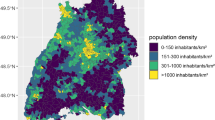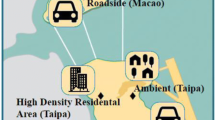Abstract
The geography and climate of the Santiago basin are, in general, unfavorable for the diffusion of air pollutants. Consequently, extreme events occur frequently during the high pollution season extending from April to August. The meteorological conditions concurrent with those extreme events are mainly associated with the leading edges of coastal lows that bring down the base of the semipermanent temperature inversion reducing the dirunal growth of the surface mixed layer. In order to produce an objective 12 to 24-hour episode forecast, a two-way multivariate discriminant analysis has been used in the definition of a meteorological air-pollution potential index (MAPPI), separating high and low meteorological air-pollution potential days. The same procedure has been applied in the selection of the most efficient predictors for the MAPPI objective forecast, based on 12 and 24 UTC radiosonde data at Quintero, about 100 km to the NW of Santiago. Results indicate about 70% correctly forecasted days, with satisfactory skill-scores relative to persistency. The strong persistency characterizing the most efficient predictors in the 12-hour objective forecast scheme, makes the prediction of the first and last days of any particular air-pollution potential episode particularly difficult. To overcome this problem, a new set of predictors based on continuous measurements near the level of the top of the temperature inversion layer (900 hPa during air-pollution episodes) is being tested. Preliminary results indicate that the time-integrated zonal wind component at that level is a reliable precursor for both the onset and the end of air-pollution potential episodes.
Similar content being viewed by others

References
Johnson, R.A. and Wichern, D.W.: 1982,Applied multivariate statistical analysis, Prentice-Hall Inc., Englewood Cliffs, New Jersey, 594 pp.
Miller, R.: 1962, ‘Statistical prediction by discriminant analysis’,Meteorological Monographs 4(25).
Panofsky, H. and Brier, G.: 1958,Some applications of statistics to meteorology, The Pennsylvania State University, 224 pp.
Preston-White, R.A.: 1975, ‘A note on some bioclimatic consequences of coastal lows’,S. Afric. Geograph. J. 57, 17–25.
Rutllant, J.: 1973,Factores meteorológicos en la contaminación atmosférica de Santiago: resultados de las mediciones 1971–1972, Pub. 164. Dpto. Geofísica, Universidad de Chile, 33 pp.
Rutllant, J.: 1981, ‘Subsidencia forzada sobre la ladera andina occidental y su relación con un episodio de contaminación atmosférica en Santiago’,Tralka 2, 57–76.
Rutllant, J. and Salinas, H.: 1982, ‘Frecuencia de ocurrencia de una condición desfavorable para la difusión de contaminantes atmosféricos en la zona central de Chile’,Tralka 2 47–160.
Rutllant, J.: 1983,Coastal lows in central Chile. Preprints I, Int. Conf. on Southern Hemisphere Meteorology, AMS, Sao José dos Campos, Brazil, July 31 – Aug. 6, 1983. 334–346.
Rutllant, J. and Salinas, H.: 1983, ‘Caracterización meteorológica de situaciones de alto potencial de contaminación atmosférica en Chile central’,Meteorologica (Argentina),XIV, 353–361.
Rutllant, J. and Fuenzalida, H.: 1987, ‘Bloqueo atmosférico en el cono sur de América conducente a un episodio de contaminación atmosférica en Santiago de Chile’, Proceedings II Congreso Interamericano de Meterorología. Bs.As. Argentina. 30 Nov–4 Dec 1987, 6.2.2–6.2.6.
Rutllant, J., Garreaud, R., Campos, E., and Aceituno, P.: 1993, ‘Meteorological Air Pollution Potential for Santiago, Chile: Towards an Objective Episode Forecasting’. Preprints IV International Conference on Meteorology and Oceanography of the Southern Hemisphere. Hobart, Australia, March 29 – April 2, 1993. American Meteorological Society. 266–267.
Rutllant, J.: 1994,On the generation of coastal lows in Central Chile, International Centre for Theoretical Physics. Internal Report IC/94/167. (Limited Distribution). Miramare-Trieste, Italy, 20 pp.
Ulriksen, P., Rosenbluth, B., and Muñoz, R.: 1992, ‘Caracterización de episodios de contaminación atmosférica en Sańtiago y su pronóstico mediante modelos estocásticos’. Final Report FONDECYT 1192–91, March 1992.
Author information
Authors and Affiliations
Rights and permissions
About this article
Cite this article
Rutllant, J., Garreaud, R. Meteorological air pollution potential for Santiago, Chile: Towards an objective episode forecasting. Environ Monit Assess 34, 223–244 (1995). https://doi.org/10.1007/BF00554796
Received:
Revised:
Issue Date:
DOI: https://doi.org/10.1007/BF00554796



